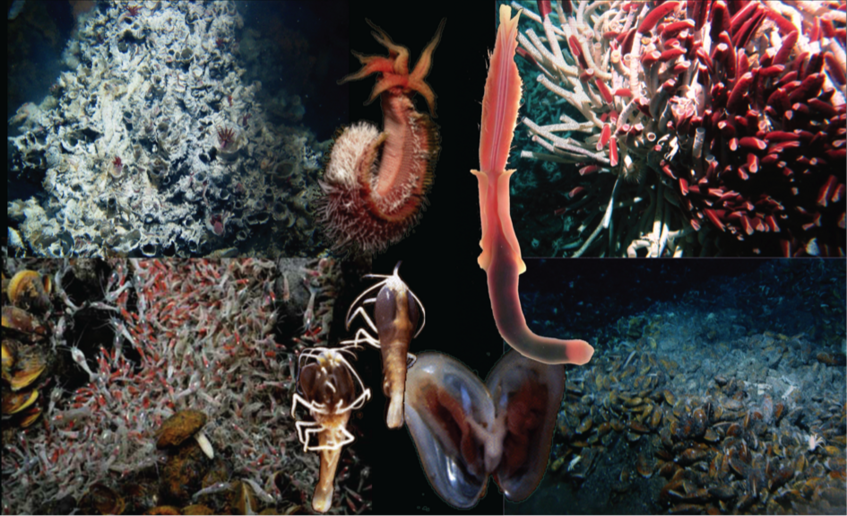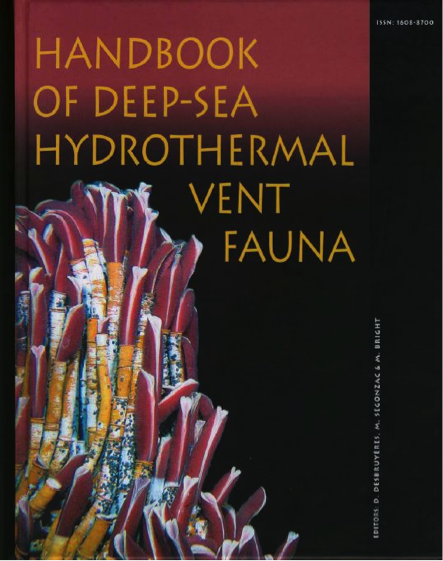
Thanks to the FWF for paying a lot of money for our first Austrian Alvin dive in 2006. Photograph: Monika Bright
Symbioses act as foundation species at hydrothermal vents. They provide a three-dimensional structure for other animals to live and ameliorate environmental conditions. In two FWF projects “Meiobenthic communities at hydrothermal vents” (2003-2007) and “Meiovent succession” (2007-2012) we studied the diversity of animal communities at the 9°50'N region of the East Pacific Rise before and after a volcanic eruption in 2005/2006. For the first time in Austria, we received money to rent Alvin for one dive each. We collected 22 samples, counted more than 74 000 animals, and found 52 meiofauna species, many of them new to science. These small animals pass through a net of 1 mm and are retained on a net of 32 µm.

Not only the vent habitats inhabited by pompei worms, tubeworms and mussels but also the “bare” basalt is full of life. Species richness and diversity increased with decreasing influence of vent emissions. This means the hotter and more toxic it gets the less animals are able to live there. Photographs © WHOI and Handbook of Deep Sea Hydrothermal Vent Fauna, 2nd edition, eds. Desbruyeres, Segonzac & Bright
After the volcanic eruption wiped out life over a large area of the 9°50'N region of the East Pacific Rise, we deployed plastic kitchen sponges as settlement substrates and followed the colonization and diversity for four years. This time we studied the entire animal community form small meio- to large macrofaunal. After collecting many sponges, counting numerous animals and identifying many individuals we discovered that at the vent habitats, the initial community recovery was relatively quick but incomplete four years after eruption but at the basalt the recovery was even slower.
Comparing the small meiofauna diversity pattern with that of large macrofauna we found that both meio- and macrofaunal species richnesses were lowest in the high-stress vent habitat, but macrofaunal richness were highest among intermediate-stress vent habitats. Meiofaunal species richness was negatively correlated with stress, and highest on the basalt. Consideration of the physiological capabilities and life history traits of different-sized animals suggests that different patterns of diversity may be caused by different capabilities to deal with environmental stress in the two size classes. In contrast to small meiofauna, adaptations of large macrofauna may have evolved to allow them to maintain their physiological homeostasis in a variety of hydrothermal vent habitats and exploit this food-rich deep-sea environment in high abundances. The habitat fidelity patterns also differed: macrofaunal species occurred primarily at vents and were generally restricted to this habitat, but meiofaunal species were distributed more evenly across proximate and distant basalt habitats and were thus not restricted to vent habitats. Over evolutionary time scales these contrasting patterns are likely driven by distinct reproduction strategies and food demands inherent to fauna of different sizes.

1. We became really good in building bioboxes to sample the sponges in separate little containers. © WHOI
2. Our settlement devices – hundreds of deployed kitchen sponges. © WHOI
3. #100 TASC for small tubeworms and sponges for community assessment collected in 2009 © WHOI
Daniel Desbruyeres and Michel Segonzac invited me to be editor of the second edition of the Handbook of Deep-Sea Hydrothermal Vent Fauna. It was good that I did not know at that time how much work that will be. In 2006 we published this book together with an exhibition at the Landesmuseum Linz, Austria.

Because the book was sold out very quickly the museum offers the pdfs without charge
www.zobodat.at/publikation_volumes.php
Desbruyeres D., Segonzac M., Bright M. 2006. Handbook of Deep-Sea Hydrothermal Vent Fauna. 2nd edition. Denisia 18, Landesmuseum Linz, Austria pp. 554.
